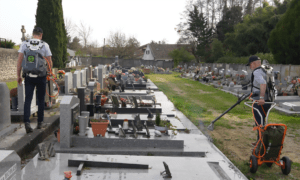
100 years is something to celebrate! As some of you may know, our company, founded in 1922, is celebrating its 100th anniversary this year. We therefore chose to celebrate this […]

There are two types of thermal weed killers, electric and gas. How to choose?
Advantages of electric devices:
Disadvantages of electrical devices :
– These are not devices for professional use
– Not recommended for use in the rain or on wet ground (risk of electric shock)
– They are less effective in windy conditions
– The zone of action is limited to 1 seedling
– Low efficiency
– Need of an appropriate extension cord
– Suitable for small areas only
– Temperature rise time varies from 5 to 45 seconds
– Electromagnetic field, not recommended for medical implants
– Nozzle must be in contact with the floor, lack of visibility of the work being done
Advantages of RIPAGREEN® products :
Disadvanatages :
If there is a downside to all non-chemical weed control solutions, it is the frequency of use. During the initial set-up, the best method to use to gain efficiency will be explained to you.
This applies to all existing alternative solutions. On average, you should expect to make about ten passes per year. The local climate, rain, sun, temperature, will increase or decrease this number.
The objective is to do it regularly but in good working conditions. The comfort, ergonomics and efficiency of the tools are therefore what should be favoured.
In the first few years, you will have to go through the soil more often to use up the number of seeds in the soil.
Whether it is water or heat, the first pass will awaken some dormant seeds. A second pass at short intervals will be very important to gain efficiency.
It is a good idea to have a landmark near your home to observe how fast weeds grow so that you can intervene as soon as possible on your sites and treat the plant when its root is the smallest. You can then get rid of it on the first pass.
Of course, the wind and the birds will always bring back new seeds, but the frequency and number of passes will be reduced from year to year as you use more and more.
You may also be interested in

100 years is something to celebrate! As some of you may know, our company, founded in 1922, is celebrating its 100th anniversary this year. We therefore chose to celebrate this […]

The year coming to an end has been especially rewarding for Ripagreen. More than ever, our teams have been out in the field, close to industry professionals, to meet, listen, […]

Weeding cemeteries is an essential task for local authorities, but it can be complicated by the layout of the site. Between the narrow aisles and the gaps between the graves, […]